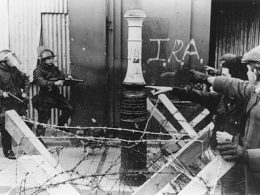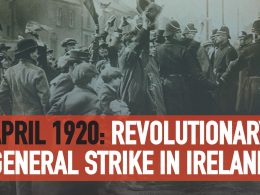The question of violence and whether we can change the world through peaceful means is a question asked often of socialists. People are generally put off by the idea of conflict, and can find talk of revolution unsettling. It conjures images of armed struggle, civil war and chaos, things that any sane person would find distressing.
So how should socialists relate to the question of violence? Understanding the role of violence in social change requires an explanation of the forces that exist in capitalist society.
Capitalism is a mode of production that didn’t always exist. Like all social systems, it grew out of the development of the forces of production of the old society, in this case feudalism, and eventually overthrew it. Just like the social and economic conditions of feudalism created the basis of capitalism, so has capitalism created the basis of socialism.
The contradictions of capitalism; the development of a majority working class who’s labour is exploited, the inability to continue to grow the productive forces on the basis of private ownership, and the endless pursuit of new markets to sell the products of labour, and thereby creating perpetual war, are factors which have themselves created the basis for a new society.
As the famous American Marxist James Cannon explained, the role of socialists “is to prepare the workers for this, to convince them of the desirability of it, to try to orgainise them to accelerate it and to bring it about in the most economical and effective way.”
This is the subjective factor that decides whether society will move forward on the basis of socialism, or whether the revolutionary movements will be violently defeated. What history teaches is that the ruling class that has outlived it’s time will not simply move aside. It will fight with everything at its disposal to maintain its rule. This is really where the question of violence arises.
So when people ask “why can’t we get socialism peacefully, through parliament?” we have to patiently explain that, while we would prefer it that way, and we will try a peaceful path as far as we can, the ruling class won’t allow it. They will resort to violence against the movement for change. In that case we have to defend ourselves and the right of the majority to move society forward. This, generally speaking, has been the Marxist position since the beginning.
The Marxist position
The first formulated statement of the Marxist position on the question of a peaceful revolution appears in Engels’ “Principles of Communism”, written in 1847. In response to the question: “Will it be possible to bring about the abolition of private property by peaceful methods?” Engels wrote: “It is to be desired that this could happen, and Communists certainly would be the last to resist it…But they also see that the development of the proletariat is in nearly every civilized country forcibly suppressed. Should the oppressed proletariat in the end be goaded into a revolution, we communists will then defend the cause of the proletarians by deed just as well as we do now by word.”
What Engels was saying, in the earliest days of the outlining the ideas of scientific socialism, is that we prefer a peaceful transition, but we can’t guarantee it on the basis of capitalist opposition, so we must be ready and prepared to defend ourselves and our aims.
In the same response he also states: “The Communists know only too well that all conspiracies are not only futile, but even harmful. They know only too well that revolutions are not made deliberately or arbitrarily, but that everywhere and at all times they have been the necessary outcome of circumstances entirely independent of the will of, and the leadership of, particular parties and entire classes.”
Engels was making this point in relation to the question of violence. Marxists do not promote minority insurrections. The socialist revolution, unlike all previous revolutions, requires the active, conscious participation of the vast majority of people in the interests of the vast majority of people.
Socialism is a democratic movement for a democratic society and its program can only be realised with the support of the majority. In this context, the question of violence becomes a question of the resistance of the capitalist minority to submit to the will of the majority.
This was very much the case in the 1917 Russian Revolution. Despite what many bourgeois historians and history text books try to portray, the Bolsheviks patiently waited and agitated until they had majority support before they took power, and the violence that happened was orchestrated by a counterrevolutionary minority against them.
The 1917 Russian Revolution
After the February 1917 revolution in Russia overthrew the Tsar, the Bolsheviks remained in a minority. They understood that in order to move society towards socialism, it is not enough to have the support of only the advanced workers. It is necessary to win over a majority of workers, the rank and file of the armed forces, and, in the case of Russia, a large section of the peasantry.
They understood that nine tenths of the task of the socialist revolution is the work of winning over the masses through explanation and organisation. Without winning a majority to the ideas of socialism, any talk of civil war and insurrection is irresponsible and counterproductive, and no road to socialism. These ideas of genuine socialism are totally counter-posed to those of individual terrorism, where winning people over to socialism is not the aim at all.
Throughout 1917, Lenin repeatedly denied that the Bolsheviks stood for violence, and placed full responsibility for violence on the shoulders of the ruling class. Yet even the famous slogan, “All Power to the Soviets” was accused of being a call to violence.
Lenin wholeheartedly refuted this, saying “Apparently, not all the supporters of the slogan ‘All Power Must Be Transferred to the Soviets’ have given adequate thought to the fact that it was a slogan for peaceful progress of the revolution—peaceful not only in the sense that nobody, no class, no force of any importance, would then have been able to resist and prevent the transfer of power to the Soviets. That is not all. Peaceful development would then have been possible, even in the sense that the struggle of classes and parties within the Soviets could have assumed a most peaceful and painless form, provided full state power had passed to the Soviets in good time.”
Trotsky summed up the position in The History of the Russian Revolution by writing: “All the efforts of the party from April to July had been directed towards making possible a peaceful development of the revolution through the Soviet.”
It was the position of the Bolsheviks to give power to the reformist leaders who then had the majority in the Workers’, Peasants’ and Soldiers’ Soviets, with the aim of democratically winning the majority within those structures. They saw this as the most peaceful road to revolution at that point.
While they were in a minority, Lenin and Trotsky argued for restraint to avoid a premature confrontation with the state. But as the reformist leaders continued to expose themselves, the Bolsheviks eventually achieved majority support in the Soviets.
But even with a majority, there was a difference of opinion between Lenin and Trotsky about the time to take power. Lenin wanted to move straight to the seizure of power in September when he was sure they had majority support in the Soviets, whereas Trotsky was in favour of postponing the insurrection until the Congress of Soviets, the vote there giving the Bolsheviks a clear mandate to take power.
This was a critical factor in achieving a peaceful transfer of power. The essential element was not military strength, or the ability to take power, but political legitimacy in the minds of the masses.
And so, on the day of the Congress of Soviets, the Military Revolutionary Committee, which was an elected organ of the Soviets, now under the influence of the Bolsheviks, orchestrated the October insurrection. They did this to defend the gains of the revolutionary movement against counterrevolution, and to defend the right of the masses to develop society in their own interests. Because they had prepared so well and won a majority to these aims, the transfer of power took place in Petrograd without any large-scale violence.
The tactics of the Bolsheviks was to pursue the most peaceful road to revolution, and when gaining a majority, taking power in order to ensure the movement wasn’t drowned in blood.
Their patient preparation was also necessary in mobilizing the masses to defend the workers’ government against the counterrevolutionary forces and the invading armies during the subsequent civil war.
Many of the unfavourable conditions that existed at the time of the Russian Revolution no longer exist today. The further development of the productive forces has meant an enormous strengthening of the working class everywhere.
Unlike during the days of the Russian Revolution, the working class is the decisive majority in every advanced capitalist country. Correspondingly, the mass base of counterrevolution, particularly the peasantry, has been diminished. This change in the objective conditions has huge consequences for the future prospects of a socialist revolution.
The increased possibility of a largely peaceful transformation of society was shown in the experience of France in 1968.
France 1968
In May 1968, France was in midst of revolution. Within days of a one-day general strike being called in solidarity with protesting students, ten million workers were out on strike. Trotsky explained that a revolution happens when the mass of people begin to participate actively in the life of society. They gain an awareness of their strength and attempt to take their future into their own hands. This is what was happening in France in May ‘68.
The French ruling class and their allies had hoped that a one-day strike would release enough steam to prevent further action. The workers decided otherwise. They spontaneously followed an example set by the Sud Aviation workers. The day after the national strike, these workers returned to their factory to occupy it. They locked up their boss, organised an action committee and went to neighboring factories and workplaces to spread the idea.
From this point the revolutionary strike picked up momentum. By the weekend two million workers were out on strike. By May 20th, six million were out and by May 24th, ten million!
With all sections of society influenced by the strike, one of the most powerful governments in the developed world was in crisis. The ruling class of France was divided and powerless. Neither adopting further repressive measures nor yielding concessions seemed capable of stopping the movement. The middle class was not just supporting the strike but was very much involved in the movement.
Police were striking, sailors mutinying and conscript soldiers declared that they would not be used against their brothers and sisters in the strike movement. The working class had almost instantaneously made irrelevant the institutions of capitalism and even the role of president.
On May 27th, the trade union negotiators won huge economic concessions form the government and the bosses. But when they were put to workers for approval, mass meetings in workplace after workplace rejected them. These reforms did not address the more fundamental and long-term needs of workers: their desire for the economy, the political system and society in general to be run by them.
Now in a hopeless position, President De Gaulle fled to Germany. The movement completely destabilised the ruling regime and could have, with a conscious revolutionary leadership, ended capitalist rule and installed a revolutionary workers’ government at that point. Tragically, there was no revolutionary party capable of leading a successful and relatively peaceful transfer of power to the working class.
And so, being reassured by the inability of the French workers’ leaders to take power, De Gaulle returned to Paris. He announced the dissolution of the assembly, new elections and a campaign against communism.
Workers were told to go back to work by the government and the union leaders. They were told to concentrate on the elections. Riot police were sent in to break up occupations and evict workers. Some deaths of students and workers resulted form this. The government and bosses, with their confidence restored, took vengeance.
Despite the eventual defeat, what the experience of France 1968 shows is that a socialist transformation of society can be achieved relatively peacefully, once the idea has absorbed every layer in society, and the workers are convinced of the need to take matters into their own hands. What they were lacking in France was a matured, revolutionary leadership to guide them.
The violence that occurred happened because the workers failed to take power. This is the experience of many other revolutions. If the movement fails to follow through and take power away from the capitalist class, and dismantle the capitalist state, the capitalists will re-instate themselves by violent force.
Revolution in Ireland
A revolutionary situation in Ireland, or any other advanced capitalist country, would likely proceed similarly to what happened in France. While it is true that the capitalist state is strong in terms of the numbers of police, soldiers and military resources, this is not the main factor. A socialist revolutionary uprising can not be understood in terms of military strength alone. It is primarily a question of social relations.
The strength that the working class has in capitalist society lies in its role in production and the functioning of every aspect of society. If workers stop work, everything grinds to a halt. If they set up their own new structures of distribution and decision making, then the old state is left in limbo.
Once the workers engage in mass struggle, showing themselves to be a powerful force in society, they can quickly win over the exploited middle classes who share more interests in common with them than the banks and monopolies of capitalism.
If the workers can win over other sections of society, as they did in France, and appeal to the soldiers and police on a class basis, they undermine the basis on which ruling class can mobilise against them. Without an army to fight for them, the capitalists would be forced to retreat.
These are the social forces that exist in the advanced capitalist world today. For this reason, the potential for an overwhelmingly peaceful transition to socialism is a greater possibility today than it was in the days of the Russian Revolution.
What is the main barrier today?
The main problem we face today is that the working class is not yet fully conscious of the collective power they hold. The reformist leaders of the labour movement internationally go to great lengths to convince the workers that they are weak and the capitalists and their state is strong. Part of their trick is to frighten the workers with the idea that revolution inevitably means violence and civil war.
Socialists can’t entertain any illusions that the capitalist class will not fight with every means at their disposal to hold onto their power and wealth. But their ability to do so depends on what means are at their disposal. And that depends, to a large extent, on the ability of a revolutionary party and the working class to appeal to all sections of society and win over the greatest number to the revolutionary cause.
While Marxists do not promote the idea of violence we are not pacifists. We understand the role of the capitalist state, and the desperation by which the capitalist class will cling to power. However, we see the question of violence as a political one, whereby the best way to ensure the most peaceful road to revolution is to mobilise the masses to undermine the material basis of counterrevolution, to undermine support for the capitalist class.
With the overwhelming support of the masses, the working class could take power peacefully, like they could have in France during 1968. In fact, once people have begun to struggle, following through with socialism is really the only viable way of avoiding violence.












